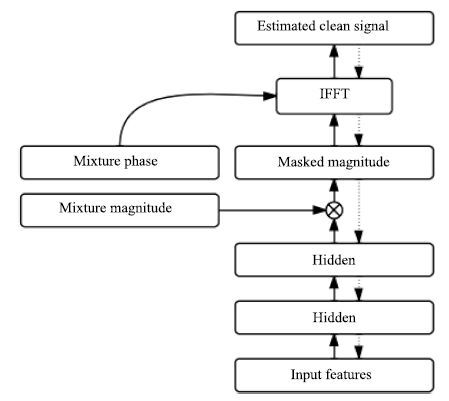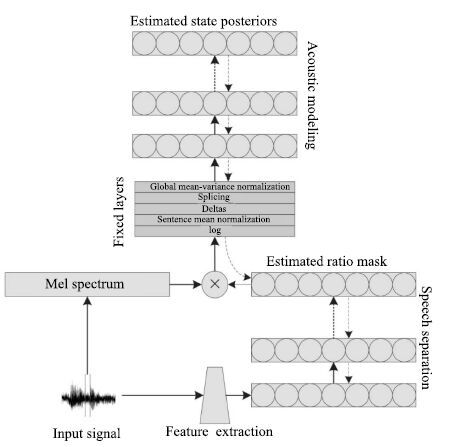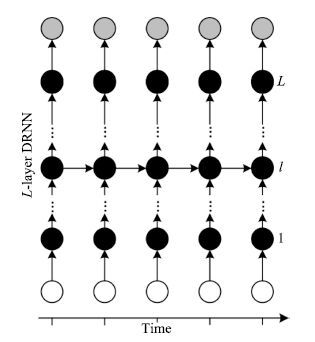|
[1]
|
Kim G, Lu Y, Hu Y, Loizou P C. An algorithm that improves speech intelligibility in noise for normal-hearing listeners. The Journal of the Acoustical Society of America, 2009, 126(3) : 1486-1494
|
|
[2]
|
Dillon H. Hearing Aids. New York: Thieme, 2001.
|
|
[3]
|
Allen J B. Articulation and intelligibility. Synthesis Lectures on Speech and Audio Processing, 2005, 1(1) : 1-124
|
|
[4]
|
Seltzer M L, Raj B, Stern R M. A Bayesian classifier for spectrographic mask estimation for missing feature speech recognition. Speech Communication, 2004, 43(4) : 379-393
|
|
[5]
|
Weninger F, Erdogan H, Watanabe S, Vincent E, Le Roux J, Hershey J R, Schuller B. Speech enhancement with LSTM recurrent neural networks and its application to noise-robust ASR. In: Proceedings of the 12th International Conference on Latent Variable Analysis and Signal Separation. Liberec, Czech Republic: Springer International Publishing, 2015. 91-99
|
|
[6]
|
Weng C, Yu D, Seltzer M L, Droppo J. Deep neural networks for single-channel multi-talker speech recognition. IEEE/ACM Transactions on Audio, Speech, and Language Processing, 2015, 23(10) : 1670-1679
|
|
[7]
|
Boll S F. Suppression of acoustic noise in speech using spectral subtraction. IEEE Transactions on Acoustics, Speech, and Signal Processing, 1979, 27(2) : 113-120
|
|
[8]
|
Chen J D, Benesty J, Huang Y T, Doclo S. New insights into the noise reduction wiener filter. IEEE Transactions on Audio, Speech, and Language Processing, 2006, 14(4) : 1218-1234
|
|
[9]
|
Loizou P C. Speech Enhancement: Theory and Practice. New York: CRC Press, 2007.
|
|
[10]
|
Liang S, Liu W J, Jiang W. A new Bayesian method incorporating with local correlation for IBM estimation. IEEE Transactions on Audio, Speech, and Language Processing, 2013, 21(3) : 476-487
|
|
[11]
|
Roweis S T. One microphone source separation. In: Proceedings of the 2000 Advances in Neural Information Processing Systems. Cambridge, MA: The MIT Press, 2000. 793-799
|
|
[12]
|
Ozerov A, Vincent E, Bimbot F. A general flexible framework for the handling of prior information in audio source separation. IEEE Transactions on Audio, Speech, and Language Processing, 2012, 20(4) : 1118-1133
|
|
[13]
|
Reddy A M, Raj B. Soft mask methods for single-channel speaker separation. IEEE Transactions on Audio, Speech, and Language Processing, 2007, 15(6) : 1766-1776
|
|
[14]
|
Mohammadiha N, Smaragdis P, Leijon A. Supervised and unsupervised speech enhancement using nonnegative matrix factorization. IEEE Transactions on Audio, Speech, and Language Processing, 2013, 21(10) : 2140-2151
|
|
[15]
|
Virtanen T. Monaural sound source separation by nonnegative matrix factorization with temporal continuity and sparseness criteria. IEEE Transactions on Audio, Speech, and Language Processing, 2007, 15(3) : 1066-1074
|
|
[16]
|
Wang D L, Brown G J. Computational Auditory Scene Analysis: Principles, Algorithms, and Applications. Piscataway: IEEE Press, 2006.
|
|
[17]
|
Wang Y X, Narayanan A, Wang D L. On training targets for supervised speech separation. IEEE/ACM Transactions on Audio, Speech, and Language Processing, 2014, 22(12) : 1849-1858
|
|
[18]
|
Xu Y, Du J, Dai L R, Lee C H. An experimental study on speech enhancement based on deep neural networks. IEEE Signal Processing Letters, 2014, 21(1) : 65-68
|
|
[19]
|
Huang P S, Kim M, Hasegawa-Johnson M, Smaragdis P. Deep learning for monaural speech separation. In: Proceedings of the 2014 IEEE International Conference on Acoustics, Speech, and Signal Processing. Florence: IEEE, 2014. 1562-1566
|
|
[20]
|
Weninger F, Hershey J R, Le Roux J, Schuller B. Discriminatively trained recurrent neural networks for single-channel speech separation. In: Proceedings of the 2014 IEEE Global Conference on Signal and Information Processing. Atlanta, GA: IEEE, 2014. 577-581
|
|
[21]
|
Wang Y X, Wang D L. A deep neural network for time-domain signal reconstruction. In: Proceedings of the 2015 IEEE International Conference on Acoustics, Speech, and Signal Processing. South Brisbane: IEEE, 2015. 4390-4394
|
|
[22]
|
Simpson A J, Roma G, Plumbley M D. Deep karaoke: extracting vocals from musical mixtures using a convolutional deep neural network. In: Proceedings of the 12th International Conference on Latent Variable Analysis and Signal Separation. Liberec, Czech Republic: Springer International Publishing, 2015. 429-436
|
|
[23]
|
Le Roux J, Hershey J R, Weninger F. Deep NMF for speech separation. In: Proceedings of the 2015 IEEE International Conference on Acoustics, Speech, and Signal Processing. South Brisbane: IEEE, 2015. 66-70
|
|
[24]
|
Gabor D. Theory of communication. Part 1: the analysis of information. Journal of the Institution of Electrical Engineers����Part III: Radio and Communication Engineering, 1946, 93(26) : 429-441
|
|
[25]
|
Patterson R, Nimmo-Smith I, Holdsworth J, Rice P. An efficient auditory filterbank based on the gammatone function. In: Proceedings of the 1987 Speech-Group Meeting of the Institute of Acoustics on Auditory Modelling. RSRE, Malvern, 1987. 2-18
|
|
[26]
|
Wang Y X, Han K, Wang D L. Exploring monaural features for classification-based speech segregation. IEEE Transactions on Audio, Speech, and Language Processing, 2013, 21(2) : 270-279
|
|
[27]
|
Chen J T, Wang Y X, Wang D L. A feature study for classification-based speech separation at low signal-to-noise ratios. IEEE/ACM Transactions on Audio, Speech, and Language Processing, 2014, 22(12) : 1993-2002
|
|
[28]
|
Huang P S, Kim M, Hasegawa-Johnson M, Smaragdis P. Singing-voice separation from monaural recordings using deep recurrent neural networks. In: Proceedings of the 15th International Society for Music Information Retrieval. Taipei, China, 2014.
|
|
[29]
|
Huang P S, Kim M, Hasegawa-Johnson M, Smaragdis P. Joint optimization of masks and deep recurrent neural networks for monaural source separation. IEEE/ACM Transactions on Audio, Speech, and Language Processing, 2015, 23(12) : 2136-2147
|
|
[30]
|
Wang Y X, Wang D L. Towards scaling up classification-based speech separation. IEEE Transactions on Audio, Speech, and Language Processing, 2013, 21(7) : 1381-1390
|
|
[31]
|
Han K, Wang D L. A classification based approach to speech segregation. The Journal of the Acoustical Society of America, 2012, 132(5) : 3475-3483
|
|
[32]
|
Han K, Wang D L. Towards generalizing classification based speech separation. IEEE Transactions on Audio, Speech, and Language Processing, 2013, 21(1) : 168-177
|
|
[33]
|
Nie S, Zhang H, Zhang X L, Liu W J. Deep stacking networks with time series for speech separation. In: Proceedings of the 2014 IEEE International Conference on Acoustics, Speech, and Signal Processing. Florence: IEEE, 2014. 6667-6671
|
|
[34]
|
Zhang H, Zhang X L, Nie S, Gao G L, Liu W J. A pairwise algorithm for pitch estimation and speech separation using deep stacking network. In: Proceedings of the 2015 IEEE International Conference on Acoustics, Speech, and Signal Processing. South Brisbane: IEEE, 2015. 246-250
|
|
[35]
|
Han K, Wang Y X, Wang D L, Woods W S, Merks I, Zhang T. Learning spectral mapping for speech dereverberation and denoising. IEEE/ACM Transactions on Audio, Speech, and Language Processing, 2015, 23(6) : 982-992
|
|
[36]
|
Nie S, Xue W, Liang S, Zhang X L, Liu W J, Qiao L W, Li J P. Joint optimization of recurrent networks exploiting source auto-regression for source separation. In: Proceedings of the 16th Annual Conference of the International Speech Communication Association. Dresden, Germany, 2015.
|
|
[37]
|
Dahl G E, Yu D, Deng L, Acero A. Context-dependent pre-trained deep neural networks for large-vocabulary speech recognition. IEEE Transactions on Audio, Speech, and Language Processing, 2012, 20(1) : 30-42
|
|
[38]
|
Wang Y X. Supervised Speech Separation Using Deep Neural Networks[Ph.D. dissertation], The Ohio State University, USA, 2015.
|
|
[39]
|
Weninger F, Eyben F, Schuller B. Single-channel speech separation with memory-enhanced recurrent neural networks. In: Proceedings of the 2014 IEEE International Conference on Acoustics, Speech, and Signal Processing. Florence: IEEE, 2014. 3709-3713
|
|
[40]
|
Hershey J R, Le Roux J, Weninger F. Deep unfolding: model-based inspiration of novel deep architectures. arXiv: 1409.2574, 2014.
|
|
[41]
|
Hsu C C, Chien J T, Chi T S. Layered nonnegative matrix factorization for speech separation. In: Proceedings of the 16th Annual Conference of the International Speech Communication Association. Dresden, Germany: ICSA, 2015. 628-632
|
|
[42]
|
Liang S, Liu W J, Jiang W, Xue W. The optimal ratio time-frequency mask for speech separation in terms of the signal-to-noise ratio. The Journal of the Acoustical Society of America, 2013, 134(5) : EL452-EL458
|
|
[43]
|
Liang S, Liu W J, Jiang W, Xue W. The analysis of the simplification from the ideal ratio to binary mask in signal-to-noise ratio sense. Speech Communication, 2014, 59: 22-30
|
|
[44]
|
Anzalone M C, Calandruccio L, Doherty K A, Carney L H. Determination of the potential benefit of time-frequency gain manipulation. Ear and Hearing, 2006, 27(5) : 480-492
|
|
[45]
|
Brungart D S, Chang P S, Simpson B D, Wang D L. Isolating the energetic component of speech-on-speech masking with ideal time-frequency segregation. The Journal of the Acoustical Society of America, 2006, 120(6) : 4007-4018
|
|
[46]
|
Li N, Loizou P C. Factors influencing intelligibility of ideal binary-masked speech: implications for noise reduction. The Journal of the Acoustical Society of America, 2008, 123(3) : 1673-1682
|
|
[47]
|
Wang D L, Kjems U, Pedersen M S, Boldt J B, Lunner T. Speech intelligibility in background noise with ideal binary time-frequency masking. The Journal of the Acoustical Society of America, 2009, 125(4) : 2336-2347
|
|
[48]
|
Hartmann W, Fosler-Lussier E. Investigations into the incorporation of the ideal binary mask in ASR. In: Proceedings of the 2011 IEEE International Conference on Acoustics, Speech, and Signal Processing. Prague: IEEE, 2011. 4804-4807
|
|
[49]
|
Narayanan A, Wang D L. The role of binary mask patterns in automatic speech recognition in background noise. The Journal of the Acoustical Society of America, 2013, 133(5) : 3083-3093
|
|
[50]
|
Paliwal K, Wójcicki K, Shannon B. The importance of phase in speech enhancement. Speech Communication, 2011, 53(4) : 465-494
|
|
[51]
|
Mowlaee P, Saiedi R, Martin R. Phase estimation for signal reconstruction in single-channel speech separation. In: Proceedings of the 2012 International Conference on Spoken Language Processing. Portland, USA: ISCA, 2012. 1-4
|
|
[52]
|
Krawczyk M, Gerkmann T. STFT phase reconstruction in voiced speech for an improved single-channel speech enhancement. IEEE/ACM Transactions on Audio, Speech, and Language Processing, 2014, 22(12) : 1931-1940
|
|
[53]
|
Williamson D S, Wang Y X, Wang D L. Complex ratio masking for monaural speech separation. IEEE/ACM Transactions on Audio, Speech, and Language Processing, 2016, 24(3) : 483-492
|
|
[54]
|
Mallat S. A Wavelet Tour of Signal Processing. Burlington: Academic Press, 1999.
|
|
[55]
|
Hermansky H, Morgan N. Rasta processing of speech. IEEE Transactions on Speech and Audio Processing, 1994, 2(4) : 578-589
|
|
[56]
|
Shao Y, Jin Z Z, Wang D L, Srinivasan S. An auditory-based feature for robust speech recognition. In: Proceedings of the 2009 IEEE International Conference on Acoustics, Speech, and Signal Processing. Taipei, China: IEEE, 2009. 4625-4628
|
|
[57]
|
Hu G N, Wang D L. A tandem algorithm for pitch estimation and voiced speech segregation. IEEE Transactions on Audio, Speech, and Language Processing, 2010, 18(8) : 2067-2079
|
|
[58]
|
Han K, Wang D L. An SVM based classification approach to speech separation. In: Proceedings of the 2011 IEEE International Conference on Acoustics, Speech, and Signal Processing. Prague: IEEE, 2011. 4632-4635
|
|
[59]
|
Narayanan A, Wang D L. Investigation of speech separation as a front-end for noise robust speech recognition. IEEE/ACM Transactions on Audio, Speech, and Language Processing, 2014, 22(4) : 826-835
|
|
[60]
|
Narayanan A, Wang D L. Improving robustness of deep neural network acoustic models via speech separation and joint adaptive training. IEEE/ACM Transactions on Audio, Speech, and Language Processing, 2015, 23(1) : 92-101
|
|
[61]
|
Wang D L. On ideal binary mask as the computational goal of auditory scene analysis. Speech Separation by Humans and Machines. US: Springer, 2005. 181-197
|
|
[62]
|
Healy E W, Yoho S E, Wang Y X, Wang D L. An algorithm to improve speech recognition in noise for hearing-impaired listeners. The Journal of the Acoustical Society of America, 2013, 134(4) : 3029-3038
|
|
[63]
|
Kjems U, Boldt J B, Pedersen M S, Lunner T, Wang D L. Role of mask pattern in intelligibility of ideal binary-masked noisy speech. The Journal of the Acoustical Society of America, 2009, 126(3) : 1415-1426
|
|
[64]
|
Srinivasan S, Roman N, Wang D L. Binary and ratio time-frequency masks for robust speech recognition. Speech Communication, 2006, 48(11) : 1486-1501
|
|
[65]
|
Hinton G E, Salakhutdinov R R. Reducing the dimensionality of data with neural networks. Science, 2006, 313(5786) : 504-507
|
|
[66]
|
Sprechmann P, Bruna J, LeCun Y. Audio source separation with discriminative scattering networks. In: Proceedings of the 12th International Conference on Latent Variable Analysis and Signal Separation. Liberec, Czech Republic: Springer International Publishing, 2015. 259-267
|





 下载:
下载:








